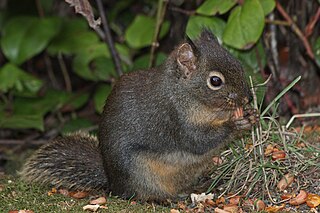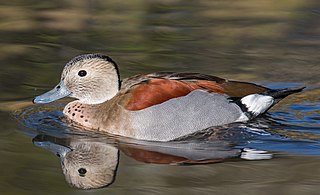Ecological selection refers to natural selection without sexual selection, i.e. strictly ecological processes that operate on a species' inherited traits without reference to mating or secondary sex characteristics. The variant names describe varying circumstances where sexual selection is wholly suppressed as a mating factor.
Ex situ conservation literally means, "off-site conservation". It is the process of protecting an endangered species, variety or breed, of plant or animal outside its natural habitat; for example, by removing part of the population from a threatened habitat and placing it in a new location, which may be a wild area or within the care of humans. The degree to which humans control or modify the natural dynamics of the managed population varies widely, and this may include alteration of living environments, reproductive patterns, access to resources, and protection from predation and mortality. Ex situ management can occur within or outside a species' natural geographic range. Individuals maintained ex situ exist outside an ecological niche. This means that they are not under the same selection pressures as wild populations, and they may undergo artificial selection if maintained ex situ for multiple generations.

The cedar waxwing is a member of the family Bombycillidae or waxwing family of passerine birds. It is a medium-sized, mostly brown, gray, and yellow bird named for its wax-like wing tips. It is a native of North and Central America, breeding in open wooded areas in southern Canada and wintering in the southern half of the United States, Central America, and the far northwest of South America. Its diet includes cedar cones, fruit, and insects. The cedar waxwing is not endangered.

The black-throated blue warbler is a small passerine bird of the New World warbler family. Its breeding ranges are located in the interior of deciduous and mixed coniferous forests in eastern North America. Over the cooler months, it migrates to islands in the Caribbean and Central America. It is very rarely found in western Europe, where it is considered to be a non-indigenous species. The black-throated blue warbler is sexually dimorphic; the adult male has a black face and cheeks, deep blue upperparts and white underparts, while the adult female is olive-brown above and light yellow below.
A true-breeding organism, sometimes also called a purebred, is an organism that always passes down certain phenotypic traits to its offspring of many generations. An organism is referred to as true breeding for each trait to which this applies, and the term "true-breeding" is also used to describe individual genetic traits.

The Douglas squirrel is a pine squirrel found in the Pacific coastal states of the United States as well as the southwestern coast of British Columbia in Canada. It is sometimes known as the chickaree or pine squirrel, although these names are also used for the American red squirrel. Variant spellings of the common name are Douglas' squirrel and Douglas's squirrel. The Native Americans of Kings River called it the "Pillillooeet", in imitation of its characteristic alarm call.

The ringed teal is a small duck of South American forests. It is the only species of the genus Callonetta. Usually placed with the dabbling ducks (Anatinae), this species may actually be closer to shelducks and belong in the subfamily Tadorninae; its closest relative is possibly the maned duck.
Tree breeding is the application of genetic, reproductive biology and economics principles to the genetic improvement and management of forest trees. In contrast to the selective breeding of livestock, arable crops, and horticultural flowers over the last few centuries, the breeding of trees, with the exception of fruit trees, is a relatively recent occurrence.

Aegolius is a genus of small true owls. The genus name is from Latin; aegolius is a type of screech owl thought to be a bird of ill omen.

Haplodiploidy is a sex-determination system in which males develop from unfertilized eggs and are haploid, and females develop from fertilized eggs and are diploid. Haplodiploidy is sometimes called arrhenotoky.

Abbott's booby is an endangered seabird of the sulid family, which includes gannets and boobies. It is a large booby, smaller than gannets, and is placed within its own monotypic genus. It was first identified from a specimen collected by William Louis Abbott, who discovered it on Assumption Island in 1892.

The red-eared firetail, also known as the boorin, is a small finch-like species of bird. It occurs in dense wetland vegetation of coastal to sub-coastal regions in Southwest Australia. Its appearance is considered appealing, with white spots, black barring and vivid crimson marks at the ear and upper tail. Red-eared firetails are usually only glimpsed briefly, if at all, as they move rapidly and discreetly through their habitat. Most observations occur when their soft voice is heard, or in flight when flushed from the dense scrub. Males and females are similar in colouring and bond as lifelong pairs that occupy a territory centred on their roosting and brooding nest site. The species occupy a similar ecological niche to the beautiful firetail Stagonopleura bella found in the east of Australia, although unlike other species of the genus they only occasionally group together and are almost never seen in large flocks.
Panmixia means random mating.
Genetic erosion is a process where the limited gene pool of an endangered species diminishes even more when reproductive individuals die off before reproducing low population. The term is sometimes used in a narrow sense, such as when describing the loss of particular alleles or genes, as well as being used more broadly, as when referring to the loss of a phenotype or whole species.
Genetic diversity is often a major consideration in e g forest crops.

The pinyon jay, historically known as the blue crow or Maximilian's jay, is a jay between the North American blue jay and the Eurasian jay in size. It is the only member of the genus Gymnorhinus, (monotypic). Its overall proportions are very nutcracker-like and indeed this can be seen as convergent evolution as both birds fill similar ecological niches. The pinyon jay is a bluish-grey coloured bird with deeper head colouring and whitish throat with black bill, legs and feet.
Quantitative trait loci mapping or QTL mapping is the process of identifying genomic regions that potentially contain genes responsible for important economic, health or environmental characters. Mapping QTLs is an important activity that plant breeders and geneticists routinely use to associate potential causal genes with phenotypes of interest. Family-based QTL mapping is a variant of QTL mapping where multiple-families are used.

Monochamus scutellatus, commonly known as the white-spotted sawyer or spruce sawyer, is a common wood-boring beetle found throughout North America. It is a species native to North America.












